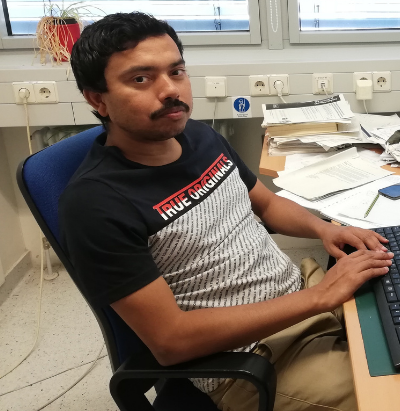-
‘Attosecond spectroscopy reveals alignment dependent core-hole dynamics in the ICl molecule’ H. J. B. Marroux, A. P. Fidler, A.Ghosh, Y. Kobayashi, K. Gokhberg , A.I. Kuleff , S. R. Leone, D. M. Neumark, Nature Communications 2020 (Accepted)
-
‘Electron transfer mediated decay of alkali dimers attached to He nanodroplets’ L. Ben Ltaief, M. Shcherbinin, S. Mandal, S. R. Krishnan, R. Richter, T. Pfeifer, A. Ghosh, M. Mudrich, K. Gokhberg, A. C. LaForge, Phys. Chem. Chem. Phys. 22, 8557 (2020 ).
-
‘Electron transfer mediated decay in HeLi2 cluster: Potential energy surfaces and Decay widths’ A. Ghosh , L.S. Cederbaum, and K. Gokhberg, J. Chem. Phys. 150, 16430 (2019)
-
‘Real-time observation of X-ray-induced intramolecular and interatomic electronic decay in CH2I2 ‘ H. Fukuzawa et al., Nature Communications 10, 2186 (2019) .
-
’Formaldehyde roaming dynamics: Comparison of quasi-classical trajectory calculations and experiments’ P. L. Houston, X. Wang, A. Ghosh, J.M. Bowman, M.S. Quinn, and S. H. Kable, J.Chem. Phys. 147, 013936 (2017).
-
‘Auger decay rates of core hole states using equation of motion coupled cluster method’ A. Ghosh, S. Pal, and N. Vaval, Chem. Phys. 482, 160 (2017).
-
‘Lifetime of inner-shell hole states of Ar (2p) and Kr (3d) using equation-of-motion coupled cluster method’ A. Ghosh, S. Pal, and N.Vaval, J. Chem. Phys. 143,024305 (2015).
-
‘Complex absorbing potential based equation-of-motion coupled cluster method for the potential energy curve of CO2− anion’ A. Ghosh, N. Vaval, S. Pal, and R. J. Bartlett, J. Chem. Phys. 141, 164113 (2014)
-
‘Coupled cluster methods for autoionisation resonances’ Y. Sajeev, A. Ghosh, N. Vaval, S. Pal, Int. Rev. Phys. Chem. 33, 397 (2014)
-
‘Relativistic equation-of-motion coupled-cluster method for the double-ionization potentials ‘ H. Pathak, A. Ghosh, B. K. Shaoo, B. P. Das, N. Vaval, and S. Pal, Phys. Rev. A 90, 010501 (R) (2014)
-
‘Interatomic coulombic decay in (HF)n (n=2,3) clusters using CAP/EOM-CCSD method’ A.Ghosh, S. Pal, and N. Vaval, Mol. Phys. 112 , 669 (2014).
-
‘Geometry-dependent lifetime of Interatomic coulombic decay using equation-of-motion coupled cluster method’ A. Ghosh and N. Vaval , J. Chem. Phys. 141, 234108 (2014).






